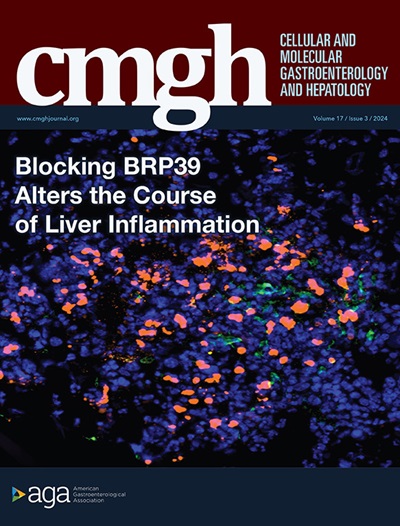Aquaporin-7 Deficiency Attenuates Liver Fibrosis by Inhibiting the Activation and Proliferation of Hepatic Stellate Cells
IF 7.1
1区 医学
Q1 GASTROENTEROLOGY & HEPATOLOGY
Cellular and Molecular Gastroenterology and Hepatology
Pub Date : 2025-01-01
DOI:10.1016/j.jcmgh.2024.101449
引用次数: 0
Abstract
Background & Aims
Aquaporin-7 (Aqp7) is an aquaglyceroporin that provides transmembrane gateway of water, glycerol, and hydrogen peroxide (H2O2). Analysis of the Gene Expression Omnibus (GEO) database revealed upregulation of hepatic AQP7 expression in liver fibrosis patients. This study aimed to elucidate the role of Aqp7 in the pathogenesis of liver fibrosis.
Methods
The GEO database analysis and TGFβ -induced human hepatic stellate cell (HSC) line LX-2 cells were used to study the relevance of AQP7 to human liver fibrosis. Bile duct ligation-induced and carbon tetrachloride-induced liver fibrosis models were employed to investigate the role of Aqp7 in liver fibrosis formation in conventional and HSC-specific Aqp7 knockout mice. Primary mouse HSCs were isolated to explore the role of Aqp7-mediated glycerol and H2O2 transport in HSC activation and proliferation.
Results
AQP7 mRNA and protein levels are remarkably upregulated in TGFβ-induced LX-2, as well as in primary mouse HSCs isolated from liver fibrosis models induced by bile duct ligation and peritoneal injection of carbon tetrachloride. Liver fibrosis formation was significantly alleviated in both conventional and HSC-specific Aqp7 knockout mice compared with their respective wild-type littermates, as evidenced by significantly decreased deposition of fibrous extracellular matrix. Aqp7 deletion resulted in the accumulation of intracellular glycerol, an increase in triglyceride content, the retention of intracellular lipid droplets, and dilatory activation of HSCs. Moreover, Aqp7 deficiency led to elevated intracellular H2O2 levels during activation, which impaired autophagy, proliferation, and survival of HSCs by disrupting relevant cell signaling pathways. Virus-mediated replacement with glycerol- or H2O2-transporting aquaporins Aqp3 or Aqp8, but not the strictly water-selective channel Aqp4, effectively rescued the impaired activation and proliferation in primary cultured Aqp7-/- HSCs.
Conclusions
Our findings suggest that Aqp7 plays a crucial role in the activation of HSCs and the formation of liver fibrosis by regulating triglyceride catabolism and maintaining reactive oxygen species homeostasis in HSCs.

水通道蛋白-7缺乏通过抑制肝星状细胞的激活和增殖来减轻肝纤维化
背景,AimsAquaporin-7 (Aqp7)是一种水甘油孔蛋白,提供水、甘油和过氧化氢(H2O2)的跨膜通道。基因表达综合数据库(Gene Expression Omnibus, GEO)分析显示,肝纤维化患者肝脏AQP7表达上调。本研究旨在阐明Aqp7在肝纤维化发病机制中的作用。方法采用GEO数据库分析和TGFβ诱导的人肝星状细胞LX-2细胞研究AQP7与人肝纤维化的相关性。采用胆管结扎诱导和四氯化碳诱导的肝纤维化模型,研究Aqp7在常规和hsc特异性Aqp7敲除小鼠肝纤维化形成中的作用。分离小鼠原代HSC,探讨aqp7介导的甘油和H2O2转运在HSC活化和增殖中的作用。结果saqp7 mRNA和蛋白水平在tgf β诱导的LX-2以及胆管结扎和腹膜注射四氯化碳诱导的肝纤维化模型小鼠原代hsc中显著上调。与野生型小鼠相比,常规小鼠和hsc特异性Aqp7基因敲除小鼠的肝纤维化形成均显著减轻,纤维细胞外基质沉积显著减少。Aqp7缺失导致细胞内甘油的积累,甘油三酯含量的增加,细胞内脂滴的保留,以及造血干细胞的扩张性激活。此外,Aqp7缺乏导致激活过程中细胞内H2O2水平升高,通过破坏相关细胞信号通路,损害造血干细胞的自噬、增殖和存活。在原代培养的Aqp7-/-造血干细胞中,病毒介导的转运甘油或h2o2的水通道蛋白Aqp3或Aqp8替代,而不是严格的水选择性通道Aqp4,有效地恢复了受损的活化和增殖。结论Aqp7通过调节造血干细胞甘油三酯分解代谢和维持活性氧稳态,在造血干细胞的活化和肝纤维化的形成中起重要作用。
本文章由计算机程序翻译,如有差异,请以英文原文为准。
求助全文
约1分钟内获得全文
求助全文
来源期刊

Cellular and Molecular Gastroenterology and Hepatology
Medicine-Gastroenterology
CiteScore
13.00
自引率
2.80%
发文量
246
审稿时长
42 days
期刊介绍:
"Cell and Molecular Gastroenterology and Hepatology (CMGH)" is a journal dedicated to advancing the understanding of digestive biology through impactful research that spans the spectrum of normal gastrointestinal, hepatic, and pancreatic functions, as well as their pathologies. The journal's mission is to publish high-quality, hypothesis-driven studies that offer mechanistic novelty and are methodologically robust, covering a wide range of themes in gastroenterology, hepatology, and pancreatology.
CMGH reports on the latest scientific advances in cell biology, immunology, physiology, microbiology, genetics, and neurobiology related to gastrointestinal, hepatobiliary, and pancreatic health and disease. The research published in CMGH is designed to address significant questions in the field, utilizing a variety of experimental approaches, including in vitro models, patient-derived tissues or cells, and animal models. This multifaceted approach enables the journal to contribute to both fundamental discoveries and their translation into clinical applications, ultimately aiming to improve patient care and treatment outcomes in digestive health.
 求助内容:
求助内容: 应助结果提醒方式:
应助结果提醒方式:


